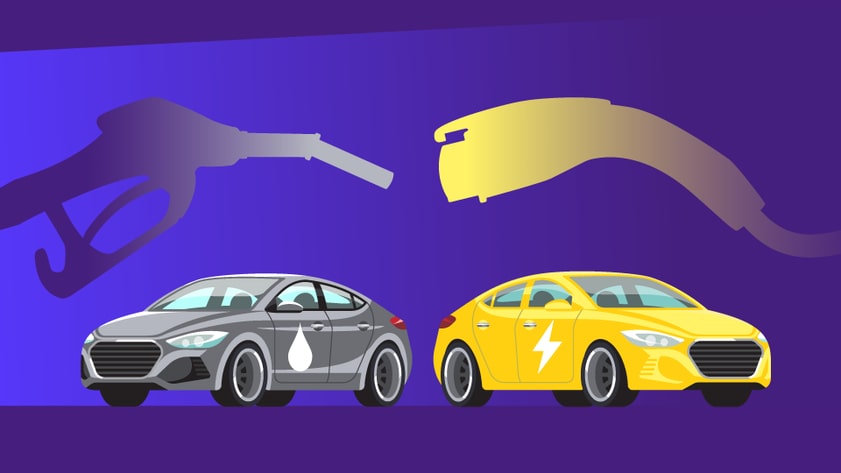Hybrid vs. Electric Cars: Advantages and Disadvantages

How We Got Here: From Internal Combustion to Electrification
In 2000, amidst rising gas prices, concerns about carbon emissions from burning petroleum, and rapid improvements in the cost and size of batteries, Toyota turned the consumer vehicle industry on its head. Their offering: the Prius, the world’s first commercially available hybrid car.
It boasted fuel efficiency that had previously been out-of-reach for a sedan—45 combined miles per gallon. But it was still bound by a reliance on fossil fuels. It would be eight more years before Tesla released their $98,000 Roadster, the first mass-produced electric vehicle (EV) that was highway legal. Since then, a slew of EVs have hit the market from more than a dozen automakers, driving costs down and popularizing the idea of an all-electric automotive future.
With so many new hybrids and EVs on the market, how can you tell which is the way to go? Read on to learn about the differences between EV vs. hybrid vehicles from cost and maintenance to range and pure driving pleasure.
Under the Hood—Hybrid vs. EV
What Makes a Car a “Hybrid”
When trying to choose between all-electric or hybrid cars, it’s important to start with the mechanics. The hybrid vehicle gets its name from its split, or hybridized, power source: the combination of an internal combustion engine (ICE) and an electric car motor. A hybrid automobile has a large battery pack—somewhere between 1 and 9kWh—and a standard 12V battery like you’d find in any ICE car. The large battery pack powers the electric car motor that helps turn the car’s wheels. The small battery powers everything a gas car uses it for: lights, stereo, gadgets, etc.
It’s easy to imagine this as a step towards the beautiful simplicity of a fully-electric vehicle, and in many ways it is. But because hybrids effectively have twice as many components as standard ICE cars, the view under the hood is far more complicated.
It doesn’t help that the mechanics work differently from make to make. Some hybrids, like Kia models, are powered by “parallel” systems: their combustion engines and electric motors engage simultaneously. e. "Series” types like those used in Toyota models alternate between combustion engine and electric motor . Still others do both at different points!
Some hybrids charge their batteries using excess energy created as the car decelerates—called “regenerative braking”—while others charge them with their combustion engines. Now, a third type of hybrid automobile has emerged, called the plug-in hybrid electric vehicle (or PHEV), which allows drivers to also charge the battery pack using an external EV charger.
Depending on which EV chargers drivers have in their homes, this can massively reduce fuel costs. Chargers come in different levels, and with different capabilities (i.e. “smart” chargers and standard chargers). When charging at home, the advantage of a Level 2 smart charger like Enel X’s JuiceBox 40 can make a huge difference. Whereas a Level 1 charger might take several hours to recharge your car after a commute that drained your battery power, a Level 2 charger can do the job up to seven to nine times faster by using a 240V outlet. What’s more, the JuiceBox smart charging station can schedule your car to charge during the time when energy is cheapest.
The Simplicity of EVs
Hybrids are more efficient than traditional ICE vehicles, but they still don’t hold a candle to the efficiency of a pure, battery-only electric vehicle (sometimes called a BEV). All the added complexity in hybrids is stripped away in EVs, which are ingenious in their simplicity. A lithium ion battery—getting recharged as you drive through regenerative braking—rapidly turns a crank in a process called “induction”, which Nikola Tesla invented. The crank then turns a few gears, the last of which are connected to a long rod (the axles), and the rod turns the wheels.
No ignition, no pistons, no cylinders. There are hundreds of moving parts in an average internal combustion engine. EVs have two. That simplicity translates to big carbon efficiency gains. Even with the carbon costs of consuming electricity to power electric cars, on average they are about four times more efficient than gas-powered cars.
Here a Level 2 smart charger becomes even more important to the driver’s experience. When you’re relying completely on electric power battery charge to get around, the ability to fully recharge quickly with the cheapest, most renewably generated “fuel”, makes the entire EV owning experience seamless.
Want to charge faster and save even more when charging an EV or plug-in hybrid?
Pros and Cons—Hybrid vs. EV
Purchase Price
When comparing hybrids and EVs to ICE vehicles, don’t be deceived by their list prices. Even though hybrids and EVs have a higher sticker price, they can often cost less right out of the gate with the incentives and rebates available at every level of government. The federal government offers up to $7,500 in tax credits for PHEVs and EVs, and more localized incentives can be stacked on top. The cash-back possibilities are greater for EVs than PHEVs, sometimes eliminating the difference in MSRP between them and comparable PHEVs. Check out our rebate tracker to find what’s available in your area.
Rebates aside, the sheer mechanical differences between EVs and ICE vehicles flip cost differences on their heads over the cars’ lifespans. Consumer Reports found that “typical total ownership savings over the life of most EVs ranges from $6,000 to $10,000,” including the purchase price.
Between hybrids and EVs, most hybrids still have lower purchase prices than the average EV, although this is rapidly changing: Quartz recently detailed how EV prices have fallen in recent years. And because hybrids have been on the market longer, there are many more types of used models to choose from. That shouldn’t deter you from shopping around for a high-quality used EV though, especially when you can get a certified pre-owned 2018 Nissan Leaf for under $15,000.
This is only going to get more common; Bloomberg NEF predicts that in just two years battery prices will have dropped sufficiently for automakers to sell EVs at the same price and profit margin, without subsidies, as ICE vehicles.
Range
Like any other gas engine vehicle, hybrids can drive for several hundred miles before needing a refuel. Plug-in hybrids are still gas-dependent for longer trips, so they offer both all-electric ranges and gas-electric ranges. For instance, the 2021 Honda Clarity Plug-In Hybrid has a 47 mile all-electric range, and a 340 mile gas-electric range on a seven- gallon gas tank. For many PHEV drivers, most of their day-to-day driving is done on battery power alone. Especially for those drivers with Level 2 smart chargers at home, the ability to get through the week with only sparse reliance on gasoline leads to incredible fuel economy.
The range of all-electric vehicles is astounding today, and only getting better. Most EVs can handle even the longest driving days without needing a charge until they return home. The 2021 Tesla Model S Long Range can go 520 miles—the distance from New York to Cleveland and then some—on a single charge, and completely recharge at home overnight. And for those infrequent road trips, public fast charging networks are proliferating rapidly.
Fuel Cost
MPG, gas-electric range, all-electric range—these are all ways of getting at one thing: how much will it cost you to keep your car fueled.
Fortunately the answer to this is much simpler than trying to compare ranges across car types: electric vehicles are far cheaper to “fuel” than any other type of car. This is true regardless of state, electricity provider, and car size. A 2020 Consumer Reports study found that “a typical EV owner who does most of their fueling at home can expect to save an average of $800 to $1,000 a year on fueling costs over an equivalent gasoline-powered car.” Fuel savings are maximized by the features of smart charging.
Maintenance
Here again electric vehicles shine. With so few moving parts, EVs require minimal maintenance—no tune-ups, oil changes, spark plug replacements, belt repairs, and so forth. The routine maintenance on EVs consists of tire care, air conditioning servicing, occasional brake cleaning and fluid testing, and engine coolant flushing. That’s it. Compared to the routine maintenance required for ICE vehicles—not accounting for unplanned maintenance—cost savings immediately add up. In fact, Consumer Reports found that EV owners spent about half as much as ICE vehicle owners over the course of their cars’ lifespan. For the first 100,000 miles, EVs are roughly 33 percent cheaper than PHEVs, and cost even less than half as much as ICE vehicles to maintain. The report found that the difference in maintenance costs between PHEVs and EVs tended even out the costs over the vehicles’ full lifespan.
Experience
Electric vehicles are a different ride altogether: stunningly quiet, no noticeable gear-shifting, wild acceleration. Most people end up vastly preferring the smooth, quiet ride to that of an ICE vehicle. In fact, J.D. Power found that 82% of EV owners “definitely will” consider buying another EV down the road. Hybrids can offer some of the performance perks EVs do, especially if they utilize parallel type engines, and so can PHEVs on relatively short trips. But in this regard, pure electric vehicles shine brightest.
Summary
When all the factors are taken together—purchase price, range, refueling costs, maintenance and experience—EVs are simply a better investment. Their net emissions are lower, they require less maintenance, they actually cost less over the lifetime of the vehicle, and they’re just more fun to drive.







